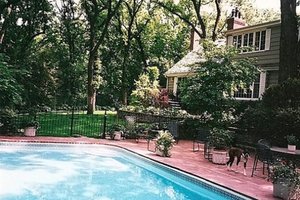Are you considering building a pool? If so, the article below by Julie Sturgeon will assist you in taking the necessary steps to make your dream a reality. You can find a host of helpful information about pools and other home improvement topics in our resource center.
If you want the ultimate backyard gathering spot, nothing fits the bill like a swimming pool.
The decision to build an in-ground pool isnít one to take lightly. Apart from the substantial installation costs, which typically run into the tens of thousands of dollars, you have to factor in ongoing maintenance expenses as well as insurance and tax implications. And you canít be assured of recouping your investment when you sell; while a pool may be attractive to some buyers, others might be put off by the upkeep or safety concerns.
If youíre looking for bang for your buck at resale, an upscale kitchen or extra bathroom offers greater impact. But if you want the ultimate backyard entertainment amenity and social gathering spot, nothing fills the bill like a swimming pool. Thinking about taking the plunge? Hereís a look at how the numbers add up.
Ballpark your installation costs
The average cost in the U.S. to install, equip, and fill a 600-square-foot concrete pool starts at $30,000. Add in aesthetic details like waterfalls, lighting, landscaping, and perhaps a spa, and youíre easily looking at totals approaching six figures.
Concrete is the most expensive pool material, but itís also the most durable and offers the most options for customization. Fiberglass shells and those with vinyl liners fall on the lower end of the budget scale, but the liners typically need replacing every 10 or so years. Changing the liner requires draining the pool and replacing the edging (called coping), so over time costs add up. Most home buyers will insist that you replace a vinyl liner, even if itís only a few years old.
Decide on a filtration and heating system
The filtration pump is the biggest energy hog in a pool system, so you want to get the most efficient pump possible. The good news here is that new, variable-speed pumps use up to 80% less energy than old single-speed pumps, cutting operating expenses dramatically. At about $1,500, these cost more up front, but some local utilities offer rebates through participating pool dealers. You can further cut energy costs by setting the pump to run at non-peak times, when rates for electricity are lower.
If youíre planning to heat your pool, gas heaters are the least expensive to purchase and install, but they typically have the highest operation and maintenance costs. Many pool owners opt instead for electric heat pumps, which extract heat from the surrounding air and transfer it to the water. Heat pumps take longer than gas to warm the pool, but theyíre more energy-efficient, costing $200 to $400 less to operate per swimming season. Regardless of heating system, covering the pool with a solar blanket to trap heat and reduce evaporation will further lower operating costs.
Account for ongoing maintenance expenses
All pools require that the water be balanced for proper pH, alkalinity, and calcium levels. They also need sanitizing to control bacteria and germs, which is where chlorine has traditionally entered the picture. These days you have a variety of options, including systems that use bromine, salt, ozone, ionizers, or other chemical compounds that can be less irritating to skin. Chlorine remains the most popular because the upfront costs are reasonable, and you donít have to be as rigid about checking the levels on a set schedule. But as far as your wallet is concerned, they all even out in the end.
In a seasonal swimming climate, budget about $600 annually for maintenance if you shoulder the chemical balancing and cleaning yourself; in a year-round climate, itís more like $15 to $25 per week. To save yourself the task of once-a-week vacuuming, you can buy a robotic cleaning system for between $500 and $800 that will do the job for you. In locations where the pool must be opened and closed for the season, add another $500 each time for a pro to handle this task.
Factor in insurance and tax implications
A basic homeowners insurance policy typically covers a pool structure without requiring a separate rider, but you should increase your liability from the standard amount. It costs about $30 a year to bump coverage from $100,000 to $500,000. Many underwriters require you to fence in the pool so that children canít wander in unsupervised.
In some areas, adding a pool may increase your annual property taxes, but it wonít necessarily add to your homeís selling price. For that reason, try to keep your total building cost between 10% and 15% of what you paid for your house, lest you invest too much in an amenity that wonít pay you back.
Julie Sturgeon has written about residential pools for nearly a decade. Her family was clueless when they bought a home with an in-ground pool, but they have avoided making a major mistake with it yet.
Used with permission of the NATIONAL ASSOCIATION OF REALTORSģ. Copyright 2010.
All rights reserved.